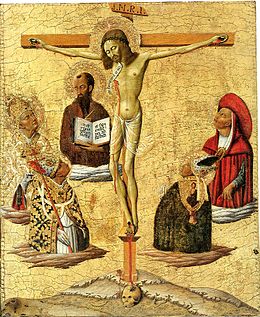Matteo di Giovanni


Matteo di Giovanni (c. 1430 – 1495) was an Italian Renaissance artist from the Sienese School.
Biography
Matteo di Giovanni di Bartolo was born in
Documentation concerning the early phases of Matteo's life and career as an artist is scanty and nothing is recorded about his apprenticeship. Left to conjecture, we might imagine him as having been trained in the workshop of sculptor/painter Lorenzo di Pietro, better known as
That Matteo had succeeded in establishing an artistic reputation is demonstrated by his selection as one of four Sienese painters who were to furnish altarpieces for the chapels of the Pienza Cathedral erected as part of the urban renewal of the town. For this prestigious commission Matteo painted three altarpieces. Dating to the years 1460–62, these paintings offer a secure point from which to evaluate Matteo's early style and to reconstruct his development as an artist.
The three paintings in Pienza also help to explain the next phase in his style. The first of these altarpieces, a large Madonna and Saints signed "Opus Matthei Johannis De Senis" depicts the enthroned Madonna surrounded by Sts. Catherine, Matthew, Bartholomew, and Lucy. The composition and figure types are reminiscent of those found in Sano di Pietro's paintings while the draperies recall the work of Vecchietta and the St. Catherine type is derived from Domenico di Bartolo. Above this panel, in a lunette, is a Flagellation of Christ scene, which, with its violent action, twisted but anatomically correct bodies, and volumetric plasticity, shows a familiarity with the progressive Florentine draftsmanship of Pollaiuolo.
Work from Matteo's middle period includes an altarpiece dated to 1477 for the oratory of

During his mature period, Matteo began to paint idyllic and naturalistic landscape scenes employing delicate, lyrical colors derived from the Umbrian school of painting. Matteo's brand of eclecticism tended to evolve from local taste and tradition. For this reason it is not surprising to find him producing delicate, sweet panels of the Madonna and Child, such as the panel from the
Matteo di Giovanni died in Siena in 1495. He is credited with teaching Guidoccio Cozzarelli (1450–1516/17) of Siena, an altarpiece painter and miniaturist.
References
- ^ This survey of Matteo di Giovanni's career is based upon that given by Alecia Holland Harper for an entry in Charles R. Mack, European Art in the Columbia Museum of Art, including the Samuel H. Kress Collection, Vol. I: The Thirteenth through the Sixteenth Century, 105–06
- ISBN 0135079470, p. 38–40.
Further reading
- "Matteo di Giovanni's lost altarpiece for Sant'Agostino, Asciano". National Gallery.
- ISBN 0870994794.) (see index; plate 68)
{{cite book}}: CS1 maint: multiple names: authors list (link - Herbermann, Charles, ed. (1913). . Catholic Encyclopedia. New York: Robert Appleton Company.
